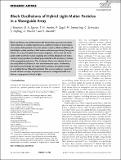Files in this item
Bloch oscillations of hybrid light-matter particles in a waveguide array
Item metadata
| dc.contributor.author | Beierlein, Johannes | |
| dc.contributor.author | Egorov, Oleg A. | |
| dc.contributor.author | Harder, Tristan H. | |
| dc.contributor.author | Gagel, Philipp | |
| dc.contributor.author | Emmerling, Monika | |
| dc.contributor.author | Schneider, Christian | |
| dc.contributor.author | Höfling, Sven | |
| dc.contributor.author | Peschel, Ulf | |
| dc.contributor.author | Klembt, Sebastian | |
| dc.date.accessioned | 2021-05-13T11:30:15Z | |
| dc.date.available | 2021-05-13T11:30:15Z | |
| dc.date.issued | 2021-05-04 | |
| dc.identifier | 272219560 | |
| dc.identifier | a9c266fb-f349-4642-85f9-5cba54c6f4cc | |
| dc.identifier | 000646744800001 | |
| dc.identifier | 85105095831 | |
| dc.identifier.citation | Beierlein , J , Egorov , O A , Harder , T H , Gagel , P , Emmerling , M , Schneider , C , Höfling , S , Peschel , U & Klembt , S 2021 , ' Bloch oscillations of hybrid light-matter particles in a waveguide array ' , Advanced Optical Materials , vol. Early View . https://doi.org/10.1002/adom.202100126 | en |
| dc.identifier.issn | 2195-1071 | |
| dc.identifier.other | ArXiv: http://arxiv.org/abs/2012.14281v1 | |
| dc.identifier.uri | https://hdl.handle.net/10023/23177 | |
| dc.description | Funding: The Würzburg and Jena group acknowledge financial support within the DFG projects PE 523/18-1 and KL3124/2-1. The Würzburg group acknowledges financial support by the German Research Foundation (DFG) under Germany’s Excellence Strategy–EXC2147 “ct.qmat” (project id 390858490). S.H. also acknowledges support by the EPSRC “Hybrid Polaritonics” grant (EP/M025330/1). T.H.H. and S.H. acknowledge funding by the doctoral training program Elitenetzwerk Bayern Graduate School “Topological insulators” (Tols 836315). T.H.H. acknowledges support by the German Academic Scholarship Foundation. | en |
| dc.description.abstract | Bloch oscillations are a phenomenon well known from quantum mechanics where electrons in a lattice experience an oscillatory motion in the presence of an electric field gradient. Here, the authors report on Bloch oscillations of hybrid light−matter particles, called exciton‐polaritons (polaritons), being confined in an array of coupled microcavity waveguides. To this end, the waveguide widths and their mutual couplings are carefully designed such that a constant energy gradient is induced perpendicular to the direction of motion of the propagating polaritons. This technique allows us to directly observe and study Bloch oscillations in real‐ and momentum‐space. Furthermore, the experimental findings are supported by numerical simulations based on a modified Gross–Pitaevskii approach. This work provides an important transfer of basic concepts of quantum mechanics to integrated solid state devices, using quantum fluids of light. | |
| dc.format.extent | 2203859 | |
| dc.language.iso | eng | |
| dc.relation.ispartof | Advanced Optical Materials | en |
| dc.subject | Bloch oscillations | en |
| dc.subject | Exciton- polariton | en |
| dc.subject | Polariton condensation | en |
| dc.subject | Waveguides | en |
| dc.subject | QC Physics | en |
| dc.subject | TK Electrical engineering. Electronics Nuclear engineering | en |
| dc.subject | NDAS | en |
| dc.subject.lcc | QC | en |
| dc.subject.lcc | TK | en |
| dc.title | Bloch oscillations of hybrid light-matter particles in a waveguide array | en |
| dc.type | Journal article | en |
| dc.contributor.sponsor | EPSRC | en |
| dc.contributor.institution | University of St Andrews. School of Physics and Astronomy | en |
| dc.contributor.institution | University of St Andrews. Condensed Matter Physics | en |
| dc.identifier.doi | 10.1002/adom.202100126 | |
| dc.description.status | Peer reviewed | en |
| dc.identifier.grantnumber | EP/M025330/1 | en |
This item appears in the following Collection(s)
Items in the St Andrews Research Repository are protected by copyright, with all rights reserved, unless otherwise indicated.

